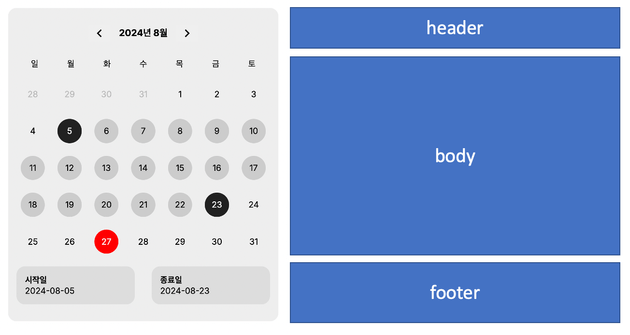얼마전 기업 기술 과제로 캘린더 컴포넌트를 만들었던 경험이 있었는데, 만들면서 꽤나 배운 점들이 많아서 기록해 보려고 합니다.
한 번 만들어봤다고 해도, 따로 정리나 기록을 해놓지 않으면 나중에 생각했을 때 남는 점이 없는 것 같아요. (만든지 일주일됐는데 벌써 가물가물한 1인..😮💨)
그런 의미에서 나중의 '나 자신'을 위해 잘 기록해 보려고 합니다. 레츠꼬~!
요구사항
캘린더 컴포넌트 구현의 요구 사항은 다음과 같았습니다.
이 컴포넌트는 사용자가 시작일과 종료일을 선택하고, 선택한 날짜를 표시할 수 있는 기능을 포함합니다.
- 캘린더는 전달과 다음달로만 이동할 수 있어야 합니다.
- 사용자는 캘린더에서 두 개의 날짜를 선택할 수 있어야 합니다.
- 사용자가 선택한 두 날짜를 별도로 표시하는 영역이 있어야 합니다.
전달과 다음달로만 이동할 수 있어야 한다는 요구사항이 있어서 오히려 다행이라고 느껴졌어요ㅎㅎ 만약 다른 달을 선택할 수 있도록 해야하면 추가 로직이 필요해질테니까요..!
컴포넌트 구조
먼저 캘린더의 컴포넌트 구조를 기능별로 나누어 다음과 같이 구성해보았습니다.
Header: 해당 년도와 달 표시, 전달과 다음달로 이동할 수 있는 버튼
Body: 날짜를 선택할 수 있는 영역
Footer: 선택된 날짜가 표시되는 영역
// components/Calendar/index.tsx
const Calendar = () => {
const {
currentDate,
currentMonthDates,
todayDate,
startDate,
setStartDate,
endDate,
setEndDate,
prevMonth,
nextMonth,
prevMonthDates,
nextMonthDates
} = useCalendar()
return (
<CalendarCell>
<CalendarHeader
currentMonth={currentDate}
prevMonth={prevMonth}
nextMonth={nextMonth}
/>
<CalendarBody
currentMonthDates={currentMonthDates()}
prevMonthDates={prevMonthDates()}
nextMonthDates={nextMonthDates()}
todayDate={todayDate()}
startDate={startDate}
setStartDate={setStartDate}
endDate={endDate}
setEndDate={setEndDate}
/>
<CalendarFooter
startDate={startDate}
endDate={endDate}
/>
</CalendarCell>
)
}
export default Calendar;
미리 스포를 해보자면, 최종 캘린더 컴포넌트 구조는 위와 같습니다.
데이터와 UI적인 요소를 분리하기 위해 데이터 관련 로직은 useCalendar 훅을 만들었습니다.
날짜 라이브러리 date-fns
date-fns는 Javascript와 Typescript는 날짜 관련 유틸리티 라이브러리입니다. 날짜를 다루는 다양한 함수들을 제공하여 날짜 및 시간 관련 작업을 쉽게 처리할 수 있도록 도와주는 라이브러리라고 하네요. 구현 과정에서 유틸리티성 라이브러리는 자유롭게 사용이 가능하다하여 빠른 작업을 위해 date-fns 라이브러리를 사용해 주었습니다.
구현
캘린더는 아래의 기준으로 구현하였습니다.
- 일요일이 첫 번째 요일로 시작한다.
- 캘린더가 꽉 찰 수 있도록 전달의 마지막 주의 날짜와 다음달의 첫 번째 주의 날짜도 표시한다.
이를 구현하기 위해서 date-fns에서 다음의 메서드들을 가져와 사용하였습니다.
format()
format() 함수를 사용하여 날짜 및 시간을 원하는 형태의 문자열로 변경할 수 있습니다.
import { format } from "date-fns"
let date = new Date();
console.log(date); // Tue Aug 15 2023 00:00:00 GMT+0900 (한국 표준시)
console.log(format(date, "yyyy-MM-d")) // 2023-08-15
console.log(format(date, "yyyy/MM/d")) // 2023/08/15
console.log(format(date, "Y")) // 2023
console.log(format(date, "M")) // 8
console.log(format(date, "d")) // 15
저는 현재 달의 년도와 월을 가져오기 위해 다음과 같이 사용해주었습니다.
const CalendarHeader = ({
currentMonth,
prevMonth,
nextMonth
}: CalendarHeaderProps ) => {
return (
<HeaderCell>
<button onClick={prevMonth}><MdKeyboardArrowLeft size={30}/></button>
<span>
{format(currentMonth, "yyyy")}년{' '}
{format(currentMonth, "M")}월
</span>
<button onClick={nextMonth}><MdKeyboardArrowRight size={30}/></button>
</HeaderCell>
)
}
export default CalendarHeader;
subMonths(), addMonths()
주어진 날짜를 기준으로 연도나 월을 증감시켜주기 위해 subMonths(), addMonths() 메서드를 사용하였습니다.
const [currentDate, setCurrentDate] = useState(new Date())
const prevMonth = () => {
setCurrentDate(subMonths(currentDate, 1))
}
const nextMonth = () => {
setCurrentDate(addMonths(currentDate, 1))
}
getYear(), getMonth()
해당 달의 첫째 날과 마지막 날을 가져오기 위해 사용하였습니다. 이는 달력에 표시할 날짜 범위를 정하는 데 사용됩니다.
const firstDayOfMonth = () => {
return new Date(getYear(currentDate), getMonth(currentDate, 1)
}
const lastDayOfMonth = () => {
return new Date(getYear(currentDate), getMonth(currentDate) + 1, 0)
}
eachDayOfInterval()
달력에 날짜를 표시하기 위해 계산한 기간 동안의 모든 날짜를 배열로 가져오기 위해 사용하였습니다.
const currentMonthDates = () => {
return eachDayOfInterval({
start: firstDayOfMonth(),
end: lastDayOfMonth()
})
}
startOfWeek(), subDays(), addDays(), endOfWeek()
주어진 날짜를 기준으로 전달과 다음달의 날짜를 배열로 가져오기 위해 사용하였습니다.
const prevMonthDates = () => {
const startDate = startOfWeek(firstDayOfMonth())
const endDate = subDays(firstDayOfMonth(), 1)
if (startDate > endDate) {
return []
}
return eachDayOfInterval({
start: startDate,
end: endDate
})
}
const NextMonthDates = () => {
const startDate = addDays(lastDayOfMonth(), 1)
const endDate = endOfWeek(lasyDayOfMonth())
if (startDate > endDate) {
return []
}
return eachDayOfInterval({
start: startDate,
end: endDate
})
}
view 구현
메서드를 조합하여 useCalendar 훅으로 만들고 구현하였습니다.

// CalendarBody 컴포넌트
const DAYS = ['일', '월', '화', '수', '목', '금', '토'];
const CalendarBody = (
{
currentMonthDates,
prevMonthDates,
nextMonthDates,
todayDate,
startDate,
setStartDate,
endDate,
setEndDate
}: DateGridProps ) => {
const handleDateClick = (date: Date) => {
if (!startDate || (startDate && endDate)) {
setStartDate(date)
setEndDate(null)
} else {
if (isBefore(date, startDate)) {
setStartDate(date)
setEndDate(null)
} else {
setEndDate(date)
}
}
}
const isDateInRange = (date: Date) => {
if (!startDate || !endDate) return false
return isBefore(date, endDate) && isAfter(date, startDate)
}
const isStartDate = (date: Date) => startDate && isSameDay(date, startDate)
const isEndDate = (date: Date) => endDate && isSameDay(date, endDate)
return (
<BodyCell>
<DaysCell>
{DAYS.map((day) => (
<DayCell key={day}>{day}</DayCell>
))}
</DaysCell>
<DatesCell>
{prevMonthDates.map((prevDate) => (
<DateCell
key={prevDate.toString()}
notCurrentMonth
isInRange={isDateInRange(prevDate)}
isStartDate={isStartDate(prevDate)}
isEndDate={isEndDate(prevDate)}
onClick={() => handleDateClick(prevDate)}
>
{getDate(prevDate)}
</DateCell>
))}
{currentMonthDates.map((currentDate) => (
<DateCell
key={currentDate.toString()}
isToday={isSameDay(currentDate, todayDate)}
isInRange={isDateInRange(currentDate)}
isStartDate={isStartDate(currentDate)}
isEndDate={isEndDate(currentDate)}
onClick={() => handleDateClick(currentDate)}
>
{getDate(currentDate)}
</DateCell>
))}
{nextMonthDates.map((nextDate) => (
<DateCell
key={nextDate.toString()}
notCurrentMonth
isInRange={isDateInRange(nextDate)}
isStartDate={isStartDate(nextDate)}
isEndDate={isEndDate(nextDate)}
onClick={() => handleDateClick(nextDate)}
>
{getDate(nextDate)}
</DateCell>
))}
</DatesCell>
</BodyCell>
)
}
export default CalendarBody;
시작일(startDate)과 종료일(endDate)도 useCalendar 훅에 넣어 공통으로 관리해주었습니다.
export default function useCalendar() {
const [startDate, setStartDate] = useState<null | Date>(null)
const [endDate, setEndDate] = useState<null | Date>(null)
...
}
const CalendarFooter = (
{
startDate,
endDate
}) => {
return (
<FooterCell>
<DateCell>
<dt>시작일</dt>
<dd>{startDate ? format(startDate, 'yyyy-MM-dd') : '날짜 입력'}</dd>
</DateCell>
<DateCell>
<dt>종료일</dt>
<dd>{endDate ? format(endDate, 'yyyy-MM-dd') : '날짜 입력'}</dd>
</DateCell>
</FooterCell>
)
}
export default CalendarFooter;
마무리
다행히 date-fns가 여러 편리한 함수를 제공해줘서 단순히 이를 잘 활용하기만 하면 돼서 생각보다 금방 만들 수 있었습니다.
간단하지만 오랜만에 제대로 된 컴포넌트를 만들어 본 것이었는데, 너무 즐거운 작업이었습니다~!
특히 처음으로 Next.js + Typescript 환경에서 작업해봤는데, 다행히 복잡한 작업은 아니라 큰 어려움은 없었습니다.
누군가에게 도움이 되는 글이었길 바라며, 문의사항이 있으시다면 댓글 부탁드려요😊
